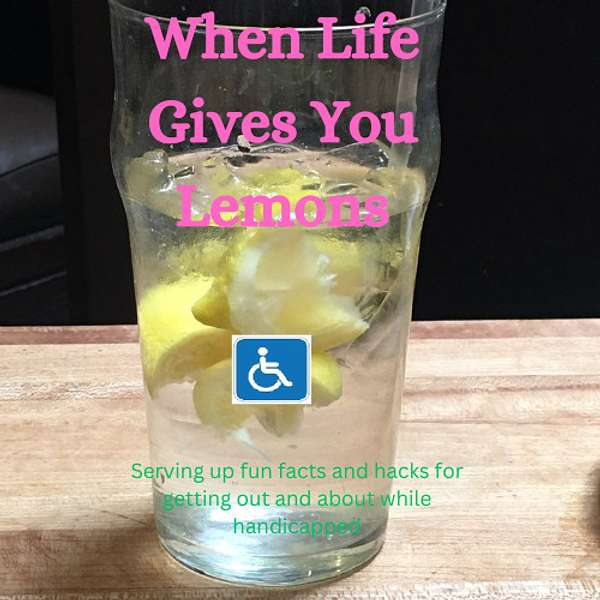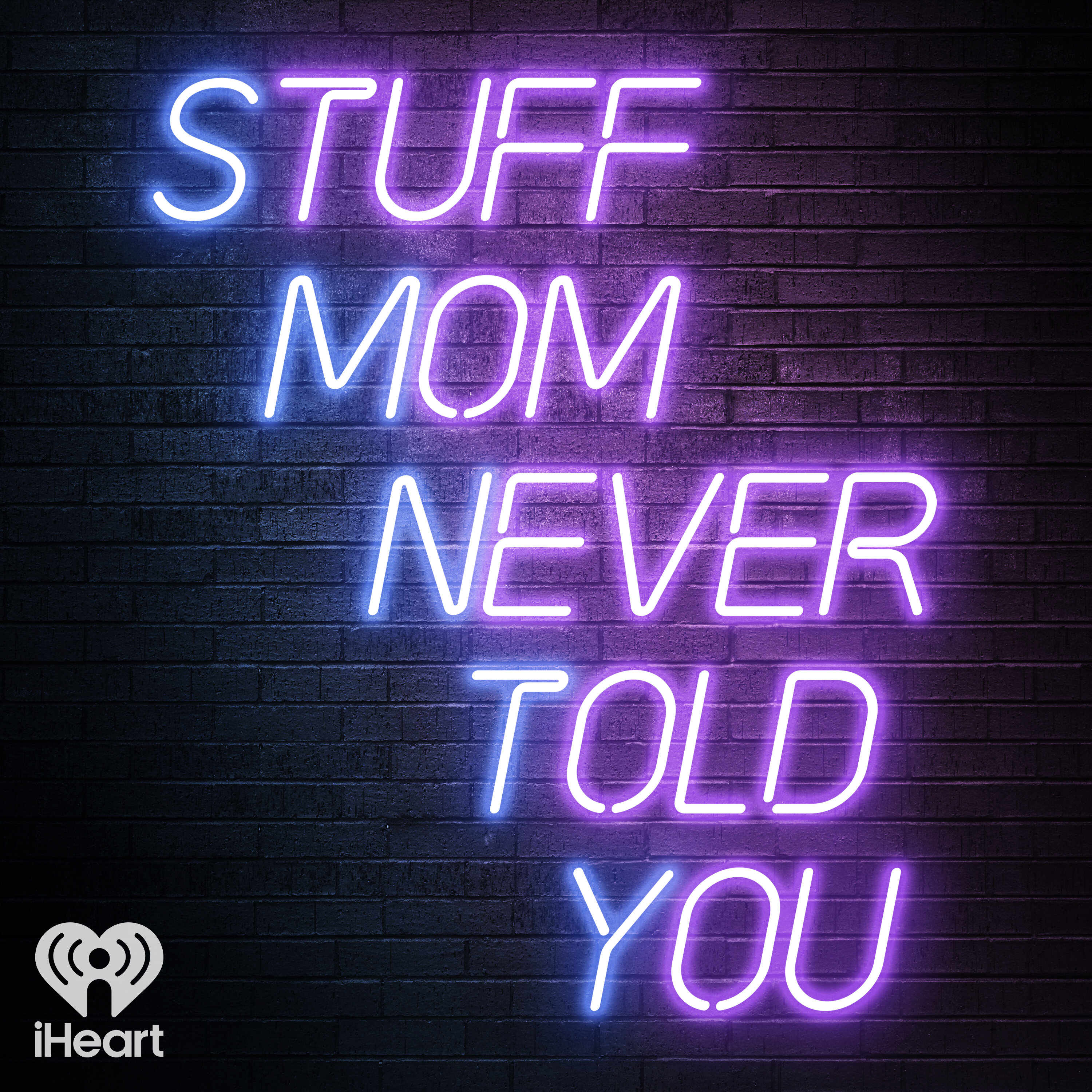
When Life Gives You Lemons
We do a bit of Research into handicapped travel issues and provide some solutions. Mobility, Hearing, Sight, Mental issues included. so far our episodes have included some information on Ataxia, Cerebral Palsy, Deafness, Dancing Sickness, Gulf War Syndrome, Long Covid and Wheelchairs. We are both Disability Advocates and realize there are too many diseases and conditions to cover and try to discuss the most common problems disabled people face and spread some awareness of disabled issues non-disabled people are unaware of.
CORRECTION
On a Previous episode I described how to enter our End Of Season contest. Step 1 click on the support our show link. Step 1 we require a one time payment (This has changed during our season) of $3. Step 3 (get you back to a one time payment) click on the $3 Subscription button. The following business day cancel the subscription (if you do it same day your bank may start thinking FRAUD. Step 4 Your done. Thanks for entering and "may the odds be forever in your favor",
When Life Gives You Lemons
So, does starting count at zero make you a cyborg?
What happens when your thoughts touch the world beyond your body—and who gets a say in what happens next? We take a grounded look at Neuralink’s latest human trials and the wider brain–computer interface landscape through the lens of disability, daily life, and real patient stories. Nolan moves a cursor and builds a career with the help of a neural implant; Andrea brings hard-won optimism after a spinal injury. Their experiences anchor a bigger question: how close are we to reliable, accessible digital autonomy for people with paralysis?
We map the state of play with clear contrasts. Neuralink’s threads chase higher-resolution control while addressing electrode stability and retraction. Synchron pursues a minimally invasive stentrode that travels through blood vessels. BlackRock Neurotech leverages decades of Utah array data, and BrainGate’s academic lineage underpins much of what works today. Beyond the demos, we focus on what actually changes life: navigating a wheelchair or computer with thought, accessing the internet, communicating faster, and turning a skill into income. We also dig into the tough parts—surgical risks, calibration time, regulatory hurdles, and a sober timeline for scale.
Then we step into the ethical and economic frontiers. Neural data is data: who owns it, stores it, and profits from it? How do we guard informed consent when features evolve and AI-generated misinformation floods the feeds? Costs remain high and coverage uncertain, so we unpack what insurers will need to see and how evidence could unlock access. Through candid debate, small jokes, and lived experience, we keep the signal clean: BCIs are real, promising, and still constrained, and the path forward must protect the person as much as it advances the tech.
If this conversation helps you think sharper about disability tech and digital autonomy, follow the show, share it with a friend, and drop a review with the one question you want answered next. Your feedback shapes what we dig into next time.
https://www.neuralink.com
Welcome to our podcast When Life Gives You Lemons. I'm Kevin.
Palmi:And I'm Palmi. We consider ourselves disability advocates and intend to spotlight some disability issues and things we find interesting that we frequently encounter when we're out and about. Also, some history on disability that we find interesting.
Kevin:Hello everybody. Welcome back to our podcast. Palmi and I are going to be talking today about some Neuralink updates. In season one, we had done some uh we'd done Neuralink, but this is 2025, a couple years later, and we thought we'd update some stuff since it has changed. Palmi, do you remember that episode?
Palmi:I do, yeah.
Kevin:Do you remember how many um patients they had?
Palmi:Three, right? Yep.
Kevin:Yeah, you have to remember that the patient numbers begin with zero. So really it was four? Yeah. They don't know how to count. No, it was really three. Patient zero, patient one, and patient two.
Palmi:No, they don't know how to count then.
Kevin:Uh actually you do. The numbers start with zero.
Palmi:Okay. Um so you wanted to check on you're just we don't teach in math class. I don't know why, but I just I think it's funny. Very highly intelligent people don't know that you start with one. But apparently we don't know that you start with zero.
Speaker 01:Well, I think it's uh probably uh during some advanced mathematics, they don't teach in high school. Thus I've never had the class.
Palmi:You start with zero.
Kevin:Yeah, start with zero.
Palmi:Okay. So um the projects presently are in human trials. We just discussed that. That there are three c three patients. The first patient was uh No, it's 12 now. Oh, but it was three then. It's 12 now.
Kevin:First patient was um who the first patient was Nolan. He was formerly patient zero.
Palmi:I thought it was um Elon Musk was the first patient.
Kevin:Well, that was patient zero. Okay, but he did just a proof of concept gave him the brain that brain computer interface. They didn't do anything operation. He got the brain computer interface, but it doesn't do anything. But he didn't have to do anything with it, but that way he had it and the engineers could work on what they need to work out, what they need to do work on.
Palmi:Okay. And then the patient number one is Nolan, right?
Kevin:Yes.
Palmi:And so the big advance is that in September of 2025, um he expressed his true name and his true goals, what his true goals were via this uh interlink.
Kevin:There's kind of a story behind that.
Palmi:Okay, go ahead.
Kevin:Okay, Nolan being the first actual patient, not Elon Musk who was a proof of concept patient. Um, he actually had some of the fibers they planned to spray and retract, and so he didn't have full contact with everything he should have had. But they're using new hardware that's mostly fixes through.
Palmi:For Elon.
Kevin:But Nolan is way better off than he was before. He could do things he couldn't do before. And am I correct that there is making a living as a motivational speaker, which is probably why he's not known as patient one anymore.
Palmi:That he's become a patient or the need.
Kevin:He'd still do the uh the things he needs to do thoroughly, they're just not sure that since some have already retracted whether or not others will in the future. So it's not like he's not one of their long-term prospects.
Palmi:Okay. And am I correct that there is a YouTube um documentary on him? Yes, and that's what you watched, yes, as far as understanding how where he's at on progress and that.
Kevin:Yeah, let me explain this to everybody, Palmi and our audience. I watched two YouTube videos updating Neuralink's progress from Neuralink's perspective. Now, to be fair, I did not use any uh when I came time to search for things I used uh Microsoft Bing, which is a chat GPT AI. It's not one that was made by Elon Musk. Correct. So in other words, if there's anything contrary, it was shown up, which it did not. It did tell me the reason why I'm speculating that Nolan was known as Patient One, and now he just came out and said, Oh, I'm Nolan, because that's what he does for a living. He's a motivational speaker now. Right.
Palmi:And the Neuralink um has studies active in Canada, the United Kingdom, the United States, and the United Arab Emirates, right?
Kevin:Yes, they're international now. Okay, whereas before they're only working with domestic patients.
Palmi:And one of these patients, and we're not sure from where, uh, is a woman. It's the first woman that was implanted.
Kevin:She's from Louisiana.
Palmi:Oh, she is. You knew that. Okay. Her name Andrea Crews, and she was implanted, um, and she broke her neck in a car accident in 2005. Nolan has been had a has implanted longer than hers and has adapted to his chip, but Andrea seems um nothing but hopeful for a future and the future of Neuralink ability to impact future patients.
Kevin:Yeah, I wanted to throw that in because Nolan was also speaking nothing but good about Neuralink as well. And it did impact his life. Yeah, before he had problems speaking, he also had a high upper spinal cord injury. He couldn't move his arms, everything was like he had like master the uh computer brain interface to learn how to use the computer and so on.
Palmi:But with the interface, he can use his arms.
Kevin:No, but I'd noticed he was in wheelchair. Some wheelchairs, like the one I have, do connect to Bluetooth, but this particular model only it has no functional connection for me. It uh it's only for the people that work on it.
Palmi:Like uh so you noticed his chair. What did you notice about his chair? Well, it's not the same brand, but you y noticed that he was using a chair that had an interface with the with him?
Kevin:Oh, he had a uh joystick. Joystick, but it was folded up like I don't use his thing. Okay. So I'm assuming he's using a Bluetooth connection to maneuver.
Palmi:Okay, so what advances did he receive from the internet? Um the narrow length.
Kevin:Well if he is indeed maneuvering his wheelchair via Bluetooth, that's one. He does I notice uh he plays uh uh chess now. He accesses the internet. He's uh about as I said, he's a motivational speaker. He was very he was housebound before, whereas now he's increasing mobility. I don't know, perhaps uh I think he said in that summer he bought a Tesla, which is would be neat if he did because with their GPS could plug in the address. Which he could do because it has Bluetooth as well, and then use self-driving features to uh say go here.
Palmi:Yeah.
Kevin:But uh again, I'm speculating. I think he said that, but I'm not sure. I didn't write it down.
Palmi:Okay. So Neuralink says that Elon Musk's brain interface company is entering a pivotative phase in 2025, while the vision revision remains bold, restoring mobility, enabling digital control, and emerging, eventually emerging human cognitive with AI. The reality is a mixture of cautionary progress uh progress and high ambitions. And here's what the future may look like. So, what they're currently their milestones are are human trials. So, as early as 2025, five in three individuals have received neuralink N1 brain implants. These trials are experimental, focused on safety, functionality, and refinement, digital freedom. One patient, the Nolan that we talked about, demonstrated the ability to control a mouse, a computer mouse, and play games using only his thoughts, thoughts, a major leap towards restoring um auto autoimmunity with people with paralysis. So that's how he he is controlling things now. And then what's next? Neuralinx aims to implant 20 to 30 people, new patients this year, while Moss envisions millions of users within a decade. The rollout is slow and deliberately due to medical safety procedures. Their advanced tech, the company is working on enhancing electrode stabilities and signal clarifications. Early issues like uh electrode retractions, like you said, are being addressed to improve long-term reliability. Uh, future goals include mind controlling games, speech restoring via AI, and even memory enhancements. Uh, their free sure their challenges ahead are regulation hurdles, despite FDA approvals for trials and full commercial deployment, will require extensive validations. Um, technical complexity, brain machine interfaces are notoriously difficult to scale, especially with biological varieties and long-term safety concerns. Um, so NarrowLake is no longer just a sci-fi dream, it's real and it's an evolving technology. While the tech the hype is high, the path to widespread use is steep and slow. Um, but there are other companies. You looked into that, and there are several other companies that are also going down this avenue, correct? Correct. And this avenue is called Brain Controlled Interface, and it's called BCI Research.
Kevin:Yeah, the other companies are Synchron, BlackRock Neurotech, BrainGate Consortium.
Palmi:I think that's the other last one. And so each of these uh companies, their advantages and they have different approaches and different features based on what they think is important. So not everybody is going down the same avenue. So what was that first one? Cycron?
Kevin:Cycron, yes.
Palmi:Minimize their approaches, minimalizate minimally invasive stent rosion devices inserted into the blood vessels. So that means they don't open up the brains. Is that correct? That's correct. They don't open up your head via brain surgery, but the uh actual surgery inserts it through the veins to the brain. And their uh progress uh currently is approved uh approved for human trials earlier than neuralink. Several patients have used it, used it to send texts and emails. So since it's not an invasive um surgery, their uh companies are more willing to do this, um, approve this, and allow this because it's not so invasive, I imagine.
Kevin:Well, I don't know about that dear, because uh right now all they're all in human trials, so right.
Palmi:But it seems like it if I was gonna if I would had a choice between having my brain opened up or a chance to just go through my blood vessels, that would be the way I'd want to go.
Kevin:I don't know.
Palmi:It seems more scalable on a scale.
Kevin:Well, like it's the only one that uses robotic surgery, so yeah. Uh I would uh You'd be more scalable. Consider that more than the others that don't use robotic surgery because I just think about like that. You have more trust in robots thing.
Palmi:Yeah. Don't I don't want people involved. So we'll see, I'm the other way around. Uh the next company is called BlackRock Neurotech, and their focus is on restoring the mobility and communications for people with paralysis. So, and their progress currently is over 30 patients have been implanted with Utah array devices proving long-term stability, and their strength is the decades of research and clinical data, strong academic partnerships.
Kevin:I think I recall seeing something reading something about the company. Their uh success that I will have today is uh they have like exoskeleton . Oh, okay. The patient controls that also move around.
Palmi:So it's not anything in that they implant.
Kevin:Yeah, if you compare with uh what's going on with the other companies, as you said, they've had 30 years of experience and no decades, I said, but 30 patients have been implanted with this device. Decades.
Palmi:Yeah.
Kevin:Uh we're probably talking, I don't know if they've ever progressed beyond that exoskeleton.
Palmi:Well, it's yeah, because it's not saying it's brain, it's it is BCI, so it must have brain controlling.
Kevin:Well, it might be just like the guy's uh computer interray face. Yeah, the patients from that company connect via Bluetooth to their device. There they go.
Palmi:Okay. And the third company is BrainGate Costor Cosortium, and its academic custor uh con uh includes Brown University, Stanford, and others. Uh achievement is it's uh pioneer early cursor control and robotic arm movement using brain signals. It's a legacy its legacy is it's demonstrated brain control functions feasible over 20 years ago. Neuralink builds on this function. So Neuralink is building on the function of the brain gate consortium.
Kevin:I think anybody involved in tech has to build on somebody else's tech nowadays.
Palmi:Yeah. They're all trying to get in the same spot.
Kevin:It's kind of rare to find a uh field in tech where nobody's done anything.
Palmi:Well, the next uh paragraph probably answers all that. It says NeuroTech is pushing boundaries with its tech and vision, but other comp groups have deeper clinical experience and broader patient data. Neurotech's flashy demos are impressive, but the race for scalable, safe, and effective brain control is wide open. The next decade of brain control interfaces, uh the next thing that they say is evolution and ethical crossroads.
Kevin:Yeah, because there are some ethical concerns in uh anything dealing with somebody's so-called private information they you know they have access to in the brain.
Palmi:Yeah.
Kevin:Which I'm sure you signed some kind of waiver before you get into any of these trials. So they're not worried about you suing them for accessing your private information. But again, I'm just guessing here.
Palmi:But all this information that they're getting and achieving from the Neuralink and all these other companies with the BCI, the brain control interfaces, it will expand um capabilities in all kinds of um, including prosthetics, wheelchairs, digital advice devices for people with prosthetics or who are paralyzed, um, sensor feedback stuff, future implants to make that may restore feeling or vision or even hearing for um the disabled.
Kevin:This really doesn't have anything to do with uh Neuralink, but uh I also read last week somewhere, some university has developed a lab grown spinal cord.
Palmi:Really?
Kevin:Yeah. So somebody's in theory, if somebody's condition requires an intact spinal cord, they can put that in in theory, like you said. I don't think technologically speaking, they're up to a uh spinal cord transplant yet, but you know, when they get there, they do have that option available to them.
Palmi:Right. And it's saying like um it's also improving advances in brain surgery and other stuff because they're learning things about the brain as they're put as they're putting these devices in there, right? So and also improving on AI interact in integration into the brain.
Kevin:Well, that's one of the things that Relink was talking about in their video. They're going beyond where they are now, you know. They know what how they can control your limbs, your arms, and legs.
Palmi:Where's that?
Kevin:They're going deeper into the brain or in the hippocampus area, which is like deep down in your brain, and that's why it's important they get the uh fibers not to be rejected and retract like they did with patient one.
Palmi:Right. When you were diagnosed 25, 26 years ago, they told us they gave you five years to live, but they said we don't know anything about the brain.
Kevin:Right.
Palmi:You know, they said that at the very beginning. They said maybe five years, maybe 30, maybe 10, we don't know. Um, it we don't know, we don't understand the brain that much to be able to give you a diagnosis. Exactly. So, and now we're in that area 25, 26 years now, from that point, where even in a tech at the ataxia game, they know more about ataxia to understand what part of the brain that it's affecting. So, yeah. So we're learning a lot. I mean, as we go, we're learning more and more about the brain. But then it comes then, we come to the fact about the ethics um about getting into somebody's brain like that. Brain control, brain data, who owns it, you know? That's gonna be, you know, we had the same issue in the internet, and now we're in a very terrible spot where no one controls the internet. So I hate to I hate to see where we're gonna be in 10, 15 years when people are hooking other people's brains up, you know what I mean, to AI and oh we're kind of falling victim to it now. Yeah, to the internet. Yeah, yeah. The internet. There's no nobody has control of it. Well, it's terrible. It's it's a bad influence, nothing.
Kevin:Okay, I'm gonna use two different examples. One is like Trump, if you are well, right now we have a government shutdown, which isn't Trump's doing, but it's Congress's doing it. But it is a political issue in this country, and by shutting down the government, basically uh they don't have any way to control uh who Trump hires and fires. So it's fired a lot of government employees right now as we speak, but that's not the issue I was talking about. I so I'm getting off topic. Um he's been uh every day he released has released uh you know, rolling what day four, so every day up till now he's been releasing a video that is poking funded his political opponents by internet. The very first one was like they were interviewing uh one of these senators from California, and he was with the uh Senate or not yeah, the Senate minority leader who's also in the same party, and he put a sombrero and mustache on the guys. Yeah, and the next day there's a whole bunch of Democrats doing an interview somewhere, and he put everybody in a sombrero in a mustache, and he added an AI image of him with the mirror out of Chip in playing Mexican music.
Palmi:Yeah. So what does this have to do with the internet being out of control?
Kevin:AI, a A AI is like can't be used in malicious ways. He was using like uh it to uh more humorously, he wasn't trying to fool anybody into thinking it was real, but he was trying to hurt people's feelings and make fun of people, but he was well, he wasn't trying to hurt people's feelings per se, but he was putting like the uh things they're saying were not what they said for real. So yeah, it could mislead somebody into believing that you know the senator said so and so he didn't because all that was fake, and nobody has so it's hard to understand what's real and what's not on on AI.
Palmi:Okay, um let's get back to the topic. So um you need to so it's hard to regulate um ethics because you don't know what's gonna happen in the future. Yeah, exactly.
Kevin:Yeah, another example of that is like if you go on YouTube, look at videos, there's a bunch of videos that don't show anybody's face and they use an AI audio, an AI gender hit there to make a video, right? And they put fictitious information out there, usually about like uh, for example, a Tesla cell phone, you know, for a very cheap price, but it's way better than you know what it's going for. Yeah, you know, it's supposed to be like a I guess if you would taunt it as an iPhone killer. Yeah.
Palmi:But you know, so there's our problem for the future, you know, how we can't regulate it now. So how you know we can't figure a way to to fix that. So how do we fix the way with when somebody has control of somebody's brain?
Kevin:Oh, as it stands right now, the platforms, i.e., like in this example, YouTube has to uh place its own videos. Yeah, and I don't think that's gonna happen because it's has to place its own videos. Twitter has to place its own videos.
Palmi:There you go.
Kevin:I don't think we're gonna fix it on this podcast, but no, we're not gonna fix it on this podcast, but we should be people uh aware that there's fraudulent information out there, and you know, like when they talk about a Tesla wheelchair for $170, and it's way better than any larger wheelchair on the market. Uh yeah, it probably doesn't really exist.
Palmi:So always take YouTube video with a grain of salt, or any other thing you see, and then you also get into weaponization and mil being military and for security and that kind of thing. That was another thing that the the information that you um you the research that you did questioned exactly.
Kevin:I think uh it falls in the category of what science fiction horrors can come true movies were made about what could come in the future, you know.
Palmi:So basically, who governs the brain?
Kevin:Exactly, yeah, where you had basically cyborgs or cybernetic soldiers who's actually in control of their thoughts, yeah.
Palmi:And then my next question is cost, how out of the range is this? I mean, is this something that a normal person could could do?
Kevin:I did ask that question, and if you get this without insurance, which right now you are because all experimental human trial, yeah, and while things are in human trial, nothing. Typically, I believe manufacturers cover costs, so yeah, as of right now, all this stuff is free, but it's not gonna be forever, and it's not gonna the typical person gets this, and uh eventually if one of these companies gets approval to proceed beyond the human trial stage, where we at, then it's like I don't know because it's really gonna depend on insurance, and insurance is good be different wherever we go.
Palmi:Well, it said uh estimated cost breakdown for the surgery right now is around the basic cost. Cost is around $10,500, and that includes the pre-op exams, the implant of the device, and the surgical labor. But the insurance to be insured, they thought it was between $40,000 and $50,000 when you involve the hospital fees, the pre-op fees, the monitoring, and all that. So kind of out of anybody's price range. Right. If with no insurance. So it's not something that, you know, in the near future that I wouldn't think that uh you could even look at without.
Kevin:Well, not until it's more sometimes uh like uh a bone numero transplant when they first came out with it. It's so expensive. Way more than it is now. Yeah, because it's cause becomes common. Because that insurance companies only exist to make money. Uh did not want to cover it. They didn't want to pay out a huge expense and not get anything back money back in their pocket.
Palmi:So I think you were looking at this as hope for you or to fix something or to to uh lengthen your life when you first started looking at it. Is that what you were looking at? But I don't think in your lifetime it's going to be anything that would be available for you.
Kevin:No, I resigned myself to the fact that in my lifetime, uh they won't be able to fix me. Right.
Palmi:But uh It's nice to know that it's out there and that if one of your relatives come happen it if this happens to be genetic or something like that, that maybe there's hope out there in the future.
Kevin:Yeah, they told me it's uh not genetic for our case, yeah. In our case, but that was there's lots of other 20 years ago. Right when they had 23 different varieties of my disease. Uh last time looked, they have 37.
Palmi:So and then we know more about the brain, too.
Kevin:So yeah.
Palmi:Well, that's our episode for today. How many more episodes do we have for the left for the season?
Kevin:We only have two more.
Palmi:Two more.
Kevin:Make sure you send that fan mail and enter a contest if you want to enter our end-of-season giveaway.
Palmi:Yep. Get on it.
Kevin:And once again, I'll say our website is www.whenlife gives you lumins.net. That's where you have to hit the uh support button and give us a donation. I tried playing around with that the other day. I look put it closer to where we actually pay for a cup of coffee around here, but it's still, I believe, a uh recurring charge. So what I'm gonna do is uh take a look at it again. It sends you a thank you email. And what I'm gonna do is include automatically instructions for how to get to the cancer. Make it a one-time donation. If I can't get the uh company to point out the button, I'm not pushing your whatever it is that's gonna set that way.
Palmi:Yep.
Kevin:So that's our show this week, folks.
Palmi:See you next episode. See ya. Till next episode. Take this moment to make your own lava and aid.
Podcasts we love
Check out these other fine podcasts recommended by us, not an algorithm.

When Life Gives You Lemons
Kevin & Palmi Henry
Stuff They Don't Want You To Know
iHeartPodcasts
Stuff Mom Never Told You
iHeartPodcasts
Stuff You Missed in History Class
iHeartPodcasts
Planet Money
NPR
Ridiculous History
iHeartPodcasts
The Way I Heard It with Mike Rowe
The Way I Heard It with Mike Rowe




